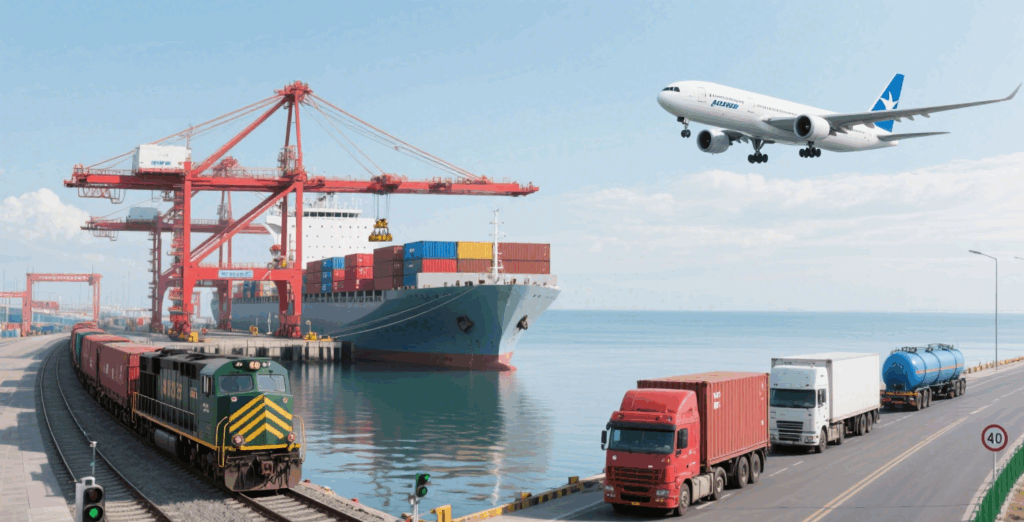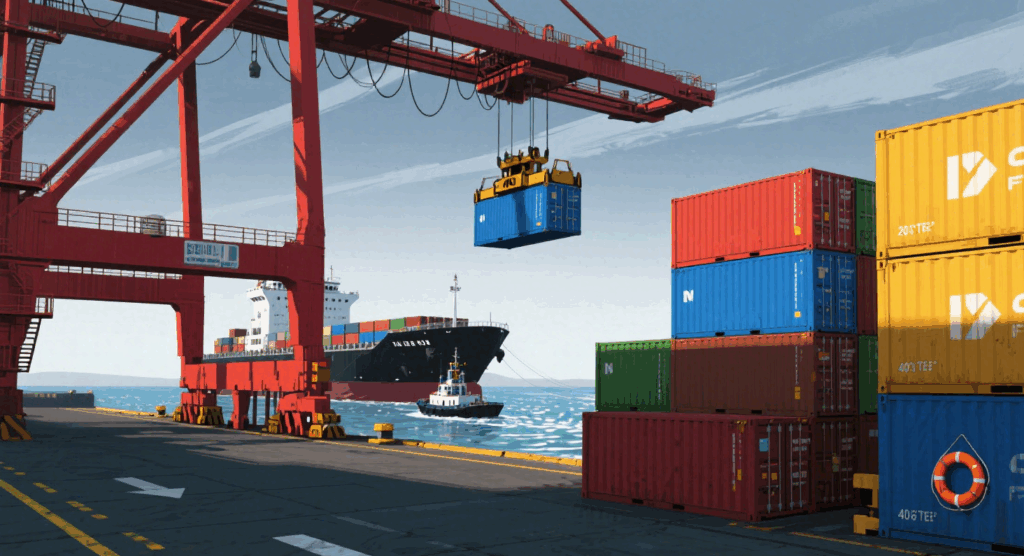Trade between China and India is one of the most significant in Asia, covering electronics, textiles, machinery, and chemicals. For importers and exporters, knowing the China to India freight charges is essential to plan budgets, manage timelines, and avoid hidden costs. However, freight pricing varies depending on method, weight, and customs duties. Moreover, without careful planning, businesses risk unnecessary surcharges and delays. This article explores costs, transit times, required documents, and real case studies to help you optimize logistics.
Why Are Freight Charges Between China and India Important?
Cross-border logistics directly affects profitability and competitiveness. Freight costs can represent up to 20% of total landed costs for goods. Consequently, understanding charges is vital for supply chain planning, inventory management, and customer pricing.
What Are the Main Freight Options?
Shippers can select sea freight, air freight, rail freight, or courier services depending on urgency and cargo type.
| Mode | Average Cost | Transit Time | Pros | Cons |
|---|---|---|---|---|
| Sea Freight (FCL) | $850–$1,300 per 20GP | 12–20 days | Cheapest for bulk cargo | Slower, port congestion |
| Sea Freight (LCL) | $80–$120 per CBM | 14–22 days | Flexible for smaller shipments | Extra handling charges |
| Air Freight | $5–$9 per kg | 3–7 days | Fast, reliable, ideal for urgent goods | Expensive for heavy cargo |
| Courier Service | $8–$15 per kg | 3–6 days | Door-to-door, tracking available | High per kg costs |
| Rail Freight | $3–$6 per kg (bulk loads) | 12–18 days | Lower cost than air, faster than sea | Limited routes, coordination needed |
Accordingly, sea freight remains the dominant mode, while air freight is popular for urgent cargo.

How Much Are China to India Freight Charges?
Container Shipping Costs
| Container Type | Average Cost (USD) | Cargo Capacity |
|---|---|---|
| 20GP | $850–$1,300 | 28–30 CBM |
| 40GP | $1,500–$1,900 | 58–60 CBM |
| 40HQ | $1,600–$2,000 | 68 CBM |
For example, a 40HQ container of textiles from Shanghai to Mumbai may cost around $1,750, with transit averaging 15 days.
Air Freight and LCL Rates
| Weight/Volume | LCL Sea Freight | Air Freight |
|---|---|---|
| 100 kg / 1 CBM | $110–$120 | $8–$9 per kg |
| 500 kg / 5 CBM | $90–$100 | $6–$7 per kg |
| 1,000 kg / 10 CBM | $80–$90 | $5–$6 per kg |
On the other hand, air freight remains the better option for time-sensitive goods such as electronics.
Which Routes Are Most Common?
Trade lanes depend on major ports and airports.
| Origin (China) | Destination (India) | Transit Time (Sea) | Notes |
|---|---|---|---|
| Shanghai | Mumbai | 13–16 days | Electronics and consumer goods |
| Shenzhen/Yantian | Chennai | 12–15 days | Apparel and machinery |
| Ningbo | Kolkata | 15–18 days | Bulk cargo, industrial supplies |
| Guangzhou | Nhava Sheva | 14–20 days | Textiles and household products |
Moreover, direct flights between Beijing, Shanghai, and Delhi enable fast courier and air freight shipments.
What Customs Documents Are Needed?
Accurate paperwork ensures smooth clearance at Indian ports.
| Document | Purpose |
|---|---|
| Bill of Lading / Airway Bill | Proof of shipment ownership |
| Commercial Invoice | Declares value of goods |
| Packing List | Describes cargo details |
| Certificate of Origin | Identifies manufacturing source |
| Import Export Code (IEC) | Required for Indian importers |
| GST Identification Number | For tax purposes in India |
| Special Permits | Needed for restricted goods (pharma, food) |
Without a doubt, incomplete documents lead to customs delays and penalties.
What Factors Influence China to India Freight Charges?
Several variables impact pricing:
- Cargo Volume & Weight – Freight is calculated by CBM or kg.
- Freight Method – Sea is cheapest, air is fastest, rail balances both.
- Customs Duties & GST – Duties range from 5%–28% depending on goods.
- Seasonality – Rates rise during Chinese New Year and Diwali.
- Port Handling Fees – Terminal charges apply at both ends.
- Fuel Prices & Surcharges – Oil price volatility affects freight costs.
In addition, supply chain disruptions can temporarily inflate charges.
Pros and Cons of Different Modes
| Mode | Pros | Cons |
|---|---|---|
| Sea Freight | Lowest per-unit cost, scalable | Long transit time |
| Air Freight | Fastest, reliable, ideal for urgent goods | Expensive per kg |
| Courier | Convenient, door-to-door tracking | Unsuitable for large cargo |
| Rail Freight | Balanced cost and speed | Limited infrastructure availability |
To summarize, choosing the right method depends on urgency, cargo size, and budget.

How to Save Money on Freight?
Importers can lower costs with proven strategies:
- Book early to secure favorable rates.
- Consolidate shipments to reduce LCL costs.
- Use FOB terms for flexibility in choosing forwarders.
- Avoid peak seasons where surcharges apply.
- Optimize packaging to reduce volumetric charges.
For instance, an importer in Delhi saved 22% by consolidating three suppliers’ orders into a single 40GP container from Ningbo.
Real Case Studies
Case 1: Electronics Shanghai → Mumbai
- Cargo: 40HQ, LED TVs (680 units)
- Mode: Sea Freight
- Cost: $1,850
- Transit: 15 days
- Result: Saved 20% by shipping one 40HQ instead of two 20GP containers.
Case 2: Apparel Shenzhen → Chennai
- Cargo: 5 CBM garments
- Mode: LCL Sea Freight
- Cost: $480
- Transit: 14 days
- Result: Reduced costs by consolidating multiple small orders.
Conclusion
The China to India freight charges depend on shipment volume, mode of transport, and customs regulations. Sea freight offers the lowest costs, air freight ensures speed, and courier services suit smaller urgent shipments. To summarize, businesses that plan shipments early, consolidate cargo, and work with experienced forwarders secure reliable delivery at the most competitive prices. Ultimately, understanding costs and processes helps importers maintain efficient supply chains while minimizing expenses.
Request a Quote
Need a tailored solution for your shipping from China?
Let TJ China Freight Forwarder assist you with reliable, cost-effective service.
FAQs
Q1.What is the cheapest mode of shipping between China and India?
Sea freight is the cheapest method, particularly for full containers. A 20GP container costs as low as $850, making it the best option for bulky shipments. Businesses importing raw materials often rely on sea freight to minimize China to India freight charges.
Q2.How long does freight from China to India take?
Sea freight takes 12–20 days depending on origin port, while air freight delivers in 3–7 days. Courier services take 3–6 days, and rail freight averages 12–18 days. These timelines help importers manage the delivery schedule from China to India effectively.
Q3.Do customs duties affect freight charges?
Yes. Duties and GST are added to freight costs. Depending on the HS code, duties may range from 5% to 28%. Importers must calculate these charges to know the total cost of shipping goods from China to India.
Q4.Can small businesses use courier services?
Yes. Courier services are ideal for shipments under 50 kg. Although more expensive per kg, they offer door-to-door delivery and tracking. Many e-commerce sellers consider this the best courier service for China to India small shipments.
Q5.How can importers reduce freight costs?
Importers can consolidate shipments, avoid peak seasons, and negotiate rates with freight forwarders. Booking early also secures better pricing. These practices help achieve the lowest China to India freight charges without sacrificing reliability.

